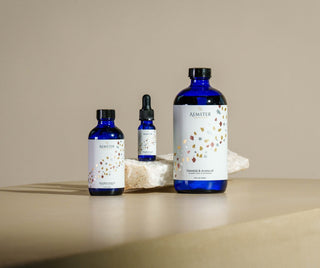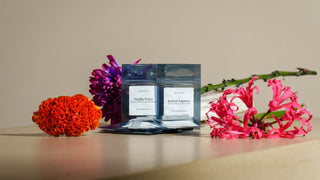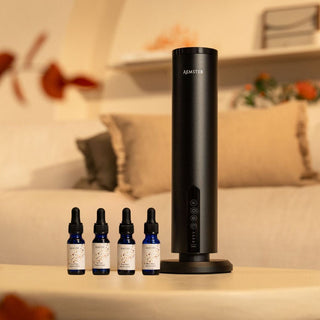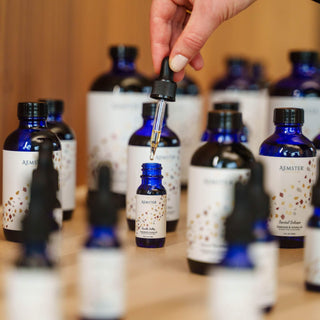Glossary
Complete concepts and glossary
Plants and plant-derived materials
Acacia – Ornamental tree producing clusters of white flowers (racemes).
Aloe – Succulent, lily-like plant, used in medicine, cosmetics, and perfumery.
Baccharis – Shrub or small tree with white or yellow umbelliferous flowers.
Calamus – Aquatic plant with aromatic rhizomes; used in perfumery and traditional medicine.
Cardamom – Aromatic seed of the ginger family, used as a spice and fragrance.
Cassia – Bark or leaves of Cinnamomum cassia; aroma similar to cinnamon.
Cedar – Tall coniferous tree valued for aromatic wood.
Coriander – Aromatic herb; seeds used as a spice and in fragrances.
Dudaim / Alruin – Aromatic plant mentioned in historical texts; sometimes associated with ceremonial or fragrance use.
Gardenia – Ornamental flowering plant with fragrant blooms, often greenhouse-cultivated.
Helenium – Flowering plant related to the sunflower.
Heliotrope – Purple-flowered plant with a sweet, vanilla-like scent.
Henna – Plant producing reddish dye for hair and skin.
Lupin – Flowering plant with fragrant blooms in clusters; part of the legume family.
Marjoram – Aromatic herb with red or white flowers, used in cooking and perfumery.
Melissa (Lemon Balm) – Lemon-scented Southern European plant (Melissa officinalis).
Mint (Mentha) – Aromatic herb from which essential oils are extracted.
Neroli – Essential oil obtained from bitter orange blossom (Citrus aurantium).
Oleander – Ornamental evergreen shrub with fragrant flowers.
Privet – Shrub with white flowers, commonly used for hedges.
Serpolet (Wild Thyme) – Small aromatic herb.
Thyme – Aromatic herb used in cooking and perfumery.
Tuberose – Tuberous plant from Mexico with strongly fragrant white flowers.
Vetiver – Tropical grass (Chrysopogon zizanioides) yielding earthy essential oil.
Ylang-ylang – Fragrant flowers of Cananga odorata; essential oil extracted for perfumery.
Rattan – Climbing ornamental palm, used for weaving and furniture.
Staghorn – Plant with antler-shaped leaves or branches.
Carob Fruit – Plant whose leaves have an astringent effect; flowers have a strong, musky aroma.
Resins, balsams, and aromatic substances
Balsam – Aromatic resin or ointment with warm, sweet fragrance, used historically in perfumes and medicine.
Benzoin – Sweet, vanilla-like resin used as a fixative in perfumery.
Mastic – Resin from Pistacia lentiscus, used in perfumery.
Myrrh – Gum-like resin with a warm, balsamic odor.
Frankincense – Aromatic resin from Boswellia trees, used in incense and perfumes.
Storax – Brownish-red resin obtained from Styrax officinalis, used in perfumery.
Souak – Bark from the walnut tree, occasionally used for fragrance or dye.
Allspice – Dried berries of Pimenta dioica, used as a spice and aromatic ingredient.
Perfumery techniques and products
Distillation – Extraction of essential oils from plants using water or steam.
Enfleurage – Traditional extraction method using animal fat to capture floral scents (e.g., jasmine, tuberose).
Extraction – Process of obtaining concentrated substances from plant material using solvents.
Extract – Concentrated solution obtained by evaporating a solvent from plant or organic material; can be liquid, dry, or solid.
Impregnation – Saturation of materials with fragrance.
Fixative – Substance that prolongs the scent of a perfume, e.g., civet, musk, or plant resins.
Essential Oil (Essence) – Concentrated aromatic plant substance obtained by distillation or cold pressing.
Ethereal Oil – Volatile plant oil, contrasted with fixed oils (like olive oil).
Eau de Cologne – Lightly scented water (Kölnisch Wasser).
Eau de Lavande – Lavender water; alcohol solution of lavender essence.
Eau de Parfum – Perfume water with high fragrance concentration; stronger than eau de toilette.
Eau de Toilette – Medium-strength fragrance water; lighter than eau de parfum.
Perfume – Highly concentrated fragrance; strongest and longest-lasting scented water.
Pomade – Scented or medicated salve applied to skin or hair.
Potpourri – Mixture of dried flowers, spices, and herbs used to scent rooms.
Pomander (Pomme d’Arbre) – Scented ball of amber or spices, historically worn or carried to ward off disease.
Cyclamal – Synthetic fragrance compound inspired by violet.
Geraniol – Floral fragrance compound present in rose oil and lily of the valley.
Hydroxycitronellal – Synthetic fragrance with a citrus-like aroma.
Indol – Floral-smelling compound found in jasmine and other flowers.
Satyrion – Orchid-inspired scent used in perfumery.
Vetaldehyde – Synthetic aldehyde used in floral and fantasy fragrances.
Historical perfumes and spirits
Eau de Carmes – Historical spirit based on melissa; not a scented water.
Eau de la Reine (Hungary) – Predecessor of Eau de Cologne; rosemary-based scented water used by Hungarian royalty.
Historical, cultural, and social terms
Autodidact – Self-taught person.
Boudoir – Private chamber of a woman.
Chaperone – Companion or guardian accompanying a young woman.
Concubine – Woman living with a man without legal marriage.
Courtesan – Woman entertaining high society, often associated with wealth and refined manners.
Hetaire – Highly trained courtesan in Ancient Greece.
Houri – Virgin in paradise, according to Islamic texts.
Fête – Celebration or festival.
Mouches – Decorative small fabric patches applied to skin in the 18th century.
Suffrage – Right to vote.
Suffragettes – Advocates for women’s voting rights circa 1900.
Proposition – Statement or announcement.
Chemicals and fragrance compounds
Aldehyde – Organic compound used in perfumery for metallic, citrus, or floral notes.
Patchouli – Small shrub yielding dark, earthy essential oil.
Coriander Oil – Essential oil extracted from coriander seeds.
Bergamot Oil – Oil from the peel of the bergamot fruit, used in perfumes and flavorings.
Neroli Oil – Essential oil from bitter orange blossom.
Mentha Oil – Essential oil from mint plants.
Hydroxycitronellal – Citrus-like synthetic fragrance.
Geraniol – Floral fragrance compound.
Indol – Floral aromatic compound.
Cyclamal – Violet-inspired synthetic fragrance.
Vetaldehyde – Floral and fantasy aldehyde.
Materials, dyes, and pigments
Pigment – Substance imparting color to skin or materials.
Red Ochre – Iron oxide clay pigment.
Kohl – Dark powder used to accentuate the eyes.
Henna – Reddish dye from the henna plant.
Tanning Agent – Substance used to convert hides into leather.
Miscellaneous
Resin – Sticky secretion from trees.
Rattan – Climbing ornamental palm.
Staghorn – Plant with antler-shaped leaves or branches.
Crimson – Deep red color.
Undulate – To move or shape in waves (e.g., hair).
Proteins – Organic compounds essential to life.
Grein – Obsolete unit of mass (~65 mg).
Retort – Flask used in distillation.
Preserve – To protect or maintain.






